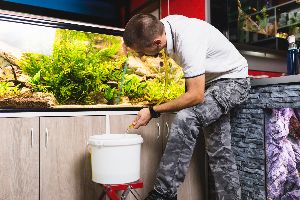
Fish and other marine animals are often low maintenance, which is partly what makes them easy pets. However, their aquariums are challenging to handle for local moving, as they’re usually fragile and heavy. While daunting, the task is doable. Read on to learn the best methods for transporting yours.
Preparation and Necessary Equipment
Purchase a siphon and enough clean containers to match the number of gallons your aquarium can hold. The containers could be buckets, tubs, or coolers. You’ll also need a net, tape, and bubble wrap or blankets.
Two weeks before moving day, clean the pumps and filters in your aquarium. In the twenty-four hours leading up to moving, avoid feeding the animals, too, so that they’ll relieve less waste and keep the water clean during the local moving process.
Transferring the Animals & Moving the Tank

To avoid shocking your animals, use a siphon hose to drain a quarter to a third of the water in the aquarium, depositing it into one of your containers. After that, gently scoop the animals out with a net and put them in the containers with the water you drained.
Next, transfer the remaining water and any rocks, gravel, sand, and aquatic plants into other containers. If your aquarium has any battery-operated pumps, filters, or heaters, put them in the containers holding the animals before loading them into your car or the moving company’s truck. Also, cover the containers with wrap or tape to prevent spills during the local moving process.
Use a wet/dry vacuum to clean the interior of the aquarium, then tape some bubble wrap or blankets around it.
Setting Up the Aquarium in the New Home
Once you’ve arrived at your new home and carried the aquarium and containers inside, set them near an electrical outlet. Remove the filters, heaters, and pumps from the containers, plug them into the outlet as needed, and install them on the aquarium. Then you can siphon the water back into the tank.
After letting the rocks, gravel, or sand settle into the tank as well, it’s safe to scoop the animals out of their containers and back into the aquarium. If the water becomes cloudy, it’s likely due to an increase in ammonia or nitrites caused by biological shock; feed the animals less and add more carbon to the water until the water clears up.
To ensure your aquarium and animals receive excellent care from local moving experts, contact Firefighters on the Move in Omaha, NE. Founded in 2007, their company specializes in both short- and long-distance moving. They’re happy to assist you not only with your marine animals but with any other pets and important or fragile belongings. No moving project is too large or too small. To learn more about how their movers can help you, call them today at (402) 850-0145 or visit their website.
About the Business
Have a question? Ask the experts!
Send your question

